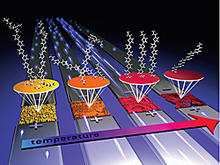Synchrotron Measurement Science and Technology: Enabling Next-Generation Materials Innovation
Problem/Challenge

The manufacture of everything from breathable, yet waterproof, fabrics to credit-card-sized portable music players depends on materials and manufacturing processes that are exquisitely controlled and reliable. The foundation for that control is the ability to understand how a material's structure and chemical composition relates to its physical properties like strength and flexibility. Consequently, to maintain a competitive edge in the global economy, the U.S. must lead in the development of scientific tools for studying many different types of advanced materials at the smallest dimensional scales.
Just as a doctor needs a variety of imaging tools (his eyes, optical microscopes, CAT scans using X-rays, MRI machines, etc.) to diagnose and treat complex diseases, modern materials science requires a suite of diagnostic instruments with specific capabilities.
Synchrotron light sources are an essential element in this research "tool kit" required for innovation in advanced materials. Synchrotrons use powerful magnets to accelerate electrons at high speeds and in the process create intense beams of light in many "colors" from longer waves of infrared light to shorter X-rays. While neutron sources are particularly good at imaging light elements like hydrogen, synchrotron light can be used to probe materials over a wide energy range to produce both microscopic and nanoscale "pictures" of two- and three-dimensional chemical structures and bonding patterns.
Proposed NIST Program
NIST proposes to accelerate innovation in U.S. materials science by creating a diverse set of scientific instruments at the National Synchrotron Light Source (NSLS) at Brookhaven National Laboratory. The initiative will build on NIST's current world-class capabilities at the NSLS. NIST is a pioneer in the synchrotron field and has already made important contributions to the U.S. chemical, microelectronics, and magnetic storage industries.
Three existing NIST beamlines at the NSLS permit structural studies of any material or device at the microscopic scale. Funding of this initiative will allow upgrades to existing instruments as well as development of two additional beamlines and associated instruments capable of analyzing the electronic, chemical, and structural properties of any material with subnanometer (less than a billionth of a meter) resolution. Some of these instruments will provide the first and/or best materials structure analysis capabilities of their type in the world.
Expected Impacts
Funding the initiative will provide NIST and about 200 academic and industrial researchers annually with the necessary tools to discover and characterize the next-generation of novel materials and structures for a host of modern products, many yet to be imagined. Access to such tools will significantly advance U.S. industry's competitive position by providing timely materials data that minimizes trial and error and reduces product development costs.

